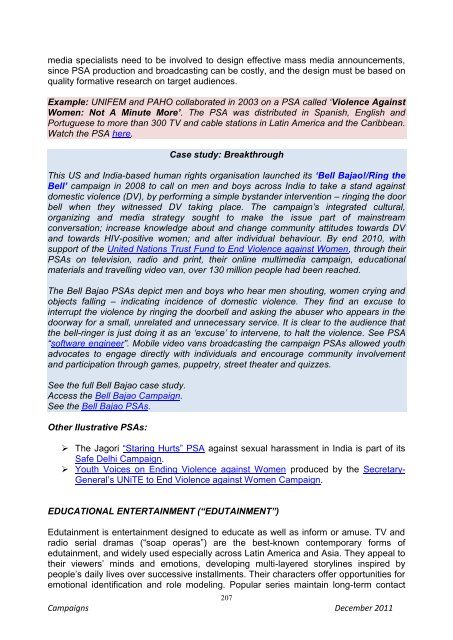Campaigns to End Violence against Women and Girls - Virtual ...
Campaigns to End Violence against Women and Girls - Virtual ...
Campaigns to End Violence against Women and Girls - Virtual ...
Create successful ePaper yourself
Turn your PDF publications into a flip-book with our unique Google optimized e-Paper software.
media specialists need <strong>to</strong> be involved <strong>to</strong> design effective mass media announcements,<br />
since PSA production <strong>and</strong> broadcasting can be costly, <strong>and</strong> the design must be based on<br />
quality formative research on target audiences.<br />
Example: UNIFEM <strong>and</strong> PAHO collaborated in 2003 on a PSA called ‘<strong>Violence</strong> Against<br />
<strong>Women</strong>: Not A Minute More’. The PSA was distributed in Spanish, English <strong>and</strong><br />
Portuguese <strong>to</strong> more than 300 TV <strong>and</strong> cable stations in Latin America <strong>and</strong> the Caribbean.<br />
Watch the PSA here.<br />
Case study: Breakthrough<br />
This US <strong>and</strong> India-based human rights organisation launched its ‘Bell Bajao!/Ring the<br />
Bell’ campaign in 2008 <strong>to</strong> call on men <strong>and</strong> boys across India <strong>to</strong> take a st<strong>and</strong> <strong>against</strong><br />
domestic violence (DV), by performing a simple byst<strong>and</strong>er intervention – ringing the door<br />
bell when they witnessed DV taking place. The campaign’s integrated cultural,<br />
organizing <strong>and</strong> media strategy sought <strong>to</strong> make the issue part of mainstream<br />
conversation; increase knowledge about <strong>and</strong> change community attitudes <strong>to</strong>wards DV<br />
<strong>and</strong> <strong>to</strong>wards HIV-positive women; <strong>and</strong> alter individual behaviour. By end 2010, with<br />
support of the United Nations Trust Fund <strong>to</strong> <strong>End</strong> <strong>Violence</strong> <strong>against</strong> <strong>Women</strong>, through their<br />
PSAs on television, radio <strong>and</strong> print, their online multimedia campaign, educational<br />
materials <strong>and</strong> travelling video van, over 130 million people had been reached.<br />
The Bell Bajao PSAs depict men <strong>and</strong> boys who hear men shouting, women crying <strong>and</strong><br />
objects falling – indicating incidence of domestic violence. They find an excuse <strong>to</strong><br />
interrupt the violence by ringing the doorbell <strong>and</strong> asking the abuser who appears in the<br />
doorway for a small, unrelated <strong>and</strong> unnecessary service. It is clear <strong>to</strong> the audience that<br />
the bell-ringer is just doing it as an ‘excuse’ <strong>to</strong> intervene, <strong>to</strong> halt the violence. See PSA<br />
“software engineer”. Mobile video vans broadcasting the campaign PSAs allowed youth<br />
advocates <strong>to</strong> engage directly with individuals <strong>and</strong> encourage community involvement<br />
<strong>and</strong> participation through games, puppetry, street theater <strong>and</strong> quizzes.<br />
See the full Bell Bajao case study.<br />
Access the Bell Bajao Campaign.<br />
See the Bell Bajao PSAs.<br />
Other Ilustrative PSAs:<br />
� The Jagori “Staring Hurts” PSA <strong>against</strong> sexual harassment in India is part of its<br />
Safe Delhi Campaign.<br />
� Youth Voices on <strong>End</strong>ing <strong>Violence</strong> <strong>against</strong> <strong>Women</strong> produced by the Secretary-<br />
General’s UNiTE <strong>to</strong> <strong>End</strong> <strong>Violence</strong> <strong>against</strong> <strong>Women</strong> Campaign.<br />
EDUCATIONAL ENTERTAINMENT (“EDUTAINMENT”)<br />
Edutainment is entertainment designed <strong>to</strong> educate as well as inform or amuse. TV <strong>and</strong><br />
radio serial dramas (“soap operas”) are the best-known contemporary forms of<br />
edutainment, <strong>and</strong> widely used especially across Latin America <strong>and</strong> Asia. They appeal <strong>to</strong><br />
their viewers’ minds <strong>and</strong> emotions, developing multi-layered s<strong>to</strong>rylines inspired by<br />
people’s daily lives over successive installments. Their characters offer opportunities for<br />
emotional identification <strong>and</strong> role modeling. Popular series maintain long-term contact<br />
207<br />
<strong>Campaigns</strong> December 2011










